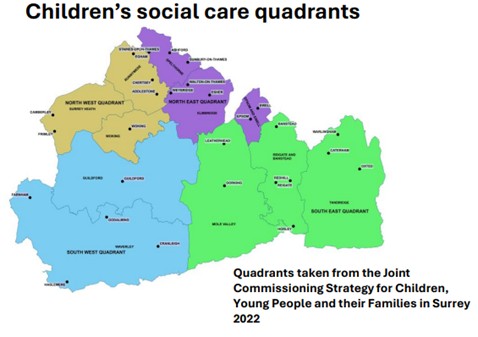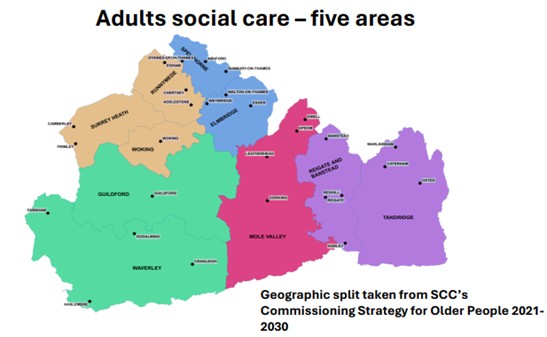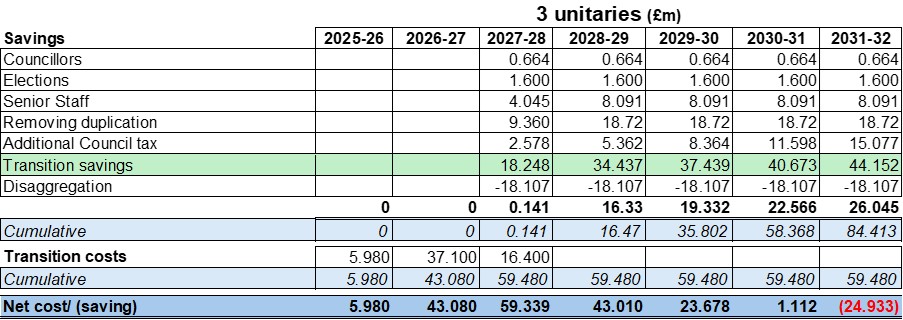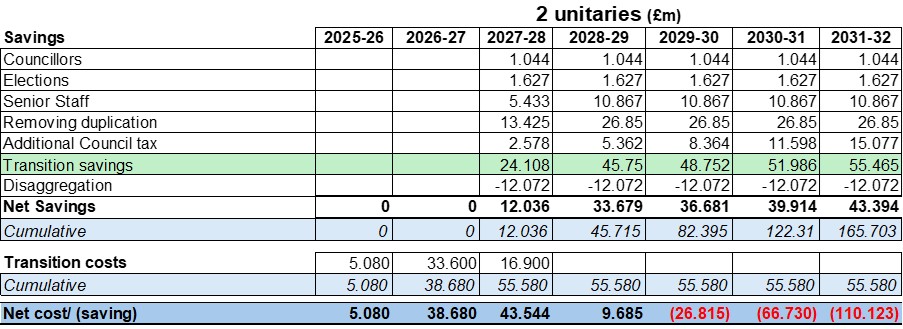Disaggregration
It will be necessary for upper-tier functions, such as highways, social care and education, to be disaggregated amongst new unitary authorities, providing opportunities for better outcomes through service alignment.
The main costs of disaggregation arise from:
- Recreating senior posts (such as Directors of Children's Services) for each unitary.
- Separating regional management lines, and loss of economies of scale from staff flexibility, for example.
- Non-staffing such as loss of economies of scale from IT licensing.
Senior posts
We have specifically modelled new senior management structures (top three tiers). There, disaggregation costs are offset by wider savings, such as reducing the number of Chief Executives in Surrey from eleven to two or three.
|
Number of senior teams |
Current Tier 1-3 Staffing |
No. of roles |
Total cost |
Average no. roles per council |
Average cost per council £m |
|---|---|---|---|---|---|
|
1 |
Surrey County Council[1] |
41 |
6.3 |
41 |
6.3 |
|
10 |
Surrey districts and boroughs[2] |
129 |
16.1 |
12.9 |
1.6 |
|
11 |
Total |
170 |
22.4 |
15.5 |
2 |
|
Number of senior teams |
Proposed Tier 1-3 Staffing |
No. of roles |
Total cost |
Average no. roles per council |
Average cost per council £m |
Saving £m |
|---|---|---|---|---|---|---|
|
2 |
2 unitaries |
74 |
11.6 |
37 |
5.8 |
10.8 |
|
3 |
3 unitaries |
96 |
14.3 |
32 |
4.8 |
8.1 |
Regional management lines
As can be seen on the maps below, Surrey County Council’s operational social care functions are already operationally configured to be delivered in a localised way, rather than on a county-wide basis, which supports disaggregation.


We know that these services are a crucial lifeline to many of Surrey’s most vulnerable residents, and they rightly expect us to continue providing high quality services. For this reason, our modelling assumes there would be no net reduction in frontline spend or staffing levels for these functions. The question of future demand is a critical one. Initially, we assume that the same level of demand exists, requiring similar numbers of frontline staff. Demand will clearly change over time, though a focus on early intervention and prevention, delivered by new unitaries with a solid understanding of their local areas, can help offset and agilely respond to these pressures.
As social care services are already delivered on a regional basis, it has been assumed that both front line staff such as social workers, and their managers would be divided between the new councils. This could therefore be done without the need for additional staff.
However within Adults’ and Children’s services, there are a number of specialist roles across the county which would have to be provided in each unitary unless they could be provided on a shared service basis. An allowance of £0.5m per unitary has been added to reflect this as an additional disaggregation cost.
For non-social care services delivered countywide, there could be a need to duplicate a degree of management costs for each unitary. An allowance has therefore been built in to reflect the management of the “service delivery” element of staffing within these services. Additional costs added total £3.1m for 2 unitaries and £5.1m for 3 unitaries.
Non-staffing disaggregation
Costs have been assumed to increase for unavoidable items, such as additional ICT systems and software which would need to be duplicated. Additional costs of around £4m per new unitary have been added to reflect this.
Wider considerations to help reduce the potential for costs to increase more than the latter include the consideration of opportunities for shared services and the ability of the new councils to reduce some costs which are currently well in excess of benchmark comparators.
Shared services
The possibility of full shared services, such as Children’s Trust models, have been discounted at this stage due to the poor performance of these elsewhere. However, there would be options for shared services for the new councils to consider such as:-
- ERP
- Shared commissioning
- Procurement
- Key professionals
- Public Health
Some services are already outsourced e.g. highways, internal audit, so there would be no need to alter this apart from changing the client from SCC to the new Councils. Joint waste services have worked well elsewhere and could also be considered.
Potential cost efficiencies
Benchmarking from Peopletoo and Oxygen show that some current unit costs in Surrey are far higher than for other comparable councils. There is therefore significant scope for savings to offset any other potential costs which could be driven out by the new unitaries over a period of time. These would be achieved through better cost and demand management through the local offer for Children’s and Adults’ Services.
Targeting high-cost and/or high-demand areas through an improved local offer, as demonstrated in other children's and adults' transformation programmes, can yield significant savings. Each 1% reduction equates to approximately £9 million in total expenditure. The local offer involves targeting market supply, managing demand differently, and focusing on prevention, which we consider later in our proposal.
Enhanced commissioning, procurement, and contract management could generate substantial savings compared to current costs, which are significantly higher than those of similar authorities.
In summary, the analysis concludes that there is no evidence to suggest that county councils achieve lower unit costs due to greater buying power. The analysis indicates that, except for S251 Residential unit costs, unitary authorities and those with a population size of 250,000 to 350,000 achieve the lowest unit costs.
Regarding demand for Adult Social Care (ASC), the analysis suggests that while counties perform well in diverting to universal services, once individuals enter statutory social care, higher numbers are placed in residential care with fewer supported in the community, thereby driving up expenditure.
Regarding Surrey specifically, the analysis of high-level expenditure data across Adult Social Care (ASC) and Children's services provides the following key points:
- Adults’ social care – As of 31/12/24, the budget stands at £516.8 million, with a forecast of £520 million, resulting in an overspend of £3.2 million.
- Expenditure on 18-64 year olds is higher in Surrey compared to their NHS Nearest Neighbours (17% higher) and the Region (23% higher).
- Expenditure on 65+ year olds is in line with NHS Nearest Neighbours and the Region, except where the primary need is learning disabilities, where spending is 17% higher than the region. This is likely due to the transition of 18-64 year olds to older age groups.
- Surprisingly, client contributions are lower in Surrey at 16% compared to 20% for NHS Nearest Neighbours. However, published finance data reveals ASC overdue debt amounting to £23 million, which may indicate challenges in timely financial assessments and debt management.
- Demand for 65+ year olds is lower at 11,345 versus 13,220 per 100,000, but expenditure per person is higher at £33,192 versus £31,578.
- Demand for 18-64 year olds is higher at 1,960 versus 1,770, with expenditure per person at £52,697 versus £44,905.
In summary, for 18-64 and 65+, expenditure per person is higher than NHS Nearest Neighbours, which suggests there is opportunity to reduce costs of care packages and for 18-64 opportunity to manage transitions and reduce demand and cost.
- Children’s social care – As at 31/12/24: Budget £299.9m, Forecast £308m, overspend £8.6m.
- Spend on Looked After Children has been increasing in line with the national picture but at a higher rate in Surrey, 44% versus 31% nationally.
- Weekly outturn costs for Looked After Children are higher than statistical neighbours – £2,340 versus £2,081 – but residential costs are lower: £1144 versus £1,365.
- Weekly outturn costs for Special Educational Needs are 27% higher than statistical neighbours and 45% than England average.
In conclusion expenditure is higher than statistical neighbours for Children’s Services, and with demand increasing this will be adding significant pressure to the budget.
|
|
Base |
SCC Budget |
2 unitary |
3 unitary |
Notes |
||
|---|---|---|---|---|---|---|---|
|
Staff |
0.00% |
245.1 |
0 |
0 |
Main staffing costs are social workers etc |
||
|
Managers |
0.00% |
22 |
0 |
0 |
Same management to staff ratios would be maintained |
||
|
Managers excl. social care |
6.50% |
45.1 |
2.9 |
4.4 |
Allowance for duplications of managers in non social-care areas |
||
|
Specialist |
10.00% |
10 |
1 |
1.5 |
Duplication of small number of specialist roles if they cannot be shared |
||
|
Non-staff |
1.00% |
814 |
8.1 |
12.2 |
Additional ICT requirements etc for multiple councils |
||
|
Total |
12.1 |
18.1 |
|||||
Indicative savings
Our analysis shows that there are significant savings to be made across both two- and three-unitary models. Further savings may also be found from greater bargaining power on contracts and reducing the number of offices and buildings required but these are likely to take time and have not been included separately from the duplication savings projected.
As shown above, the costs of reorganisation are approximately £60m, resulting in a reorganisation cost benefit analysis that suggests that the costs would be paid off by 2029/30 for two unitaries and 2030/31 for three unitaries. The benefit is roughly £17m per annum greater for two unitaries than for three.
Potential benefits for transformation range from £40m for three unitaries to £46m for two unitaries. It is estimated that these savings will be delivered by the end of year 3 after vesting day for the new unitaries.
This form helps us improve the content and structure of our webpages only, and we cannot provide a response to any submission below.



